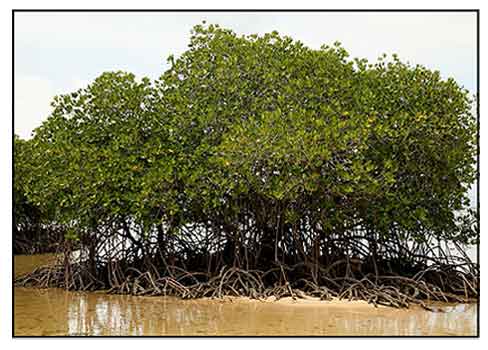 Gen info Gen info
- The mangrove vegetation is a taxonomically diverse group of trees and shrubs dominant in tidal and salty marshes along sheltered tropical and subtropical coastlines. They have been classified as halophytes (salt tolerant), thriving in saline conditions wit daily inundation between mean sea level and highest astronomical tides, surviving extreme conditions of high salinity, strong winds, tidal changes, high temperature and anaerobic tidal swamps. (6)
-
Rhizophora is a genus of tropical mangrove trees, sometimes collectively called true mangroves.
- Etymology: The genus name Rhizophora derives from Greek words rhiza, meaning "root", and phoros, meaning "bearing", referring to the stilt-roots. The species epithet stylosa derives from Latin meaning "stylus form", referring to the flower.
- There are eight bakauan species in the genus Rhizophora. Three are found in the Philippines: R. mucronata (bakauan babae), R. stylosa (bakauan bato or bangkao), and R. apiculata (bakauan lalaki). There may be a fourth, bakauan hybrid pula, first sighted by C. E, Yao in the Visayas in 1984.
Further sightings in Bohol confirmed a report by mangrove expert Fred Vande Vusse who believes the species could be Rhizophora x lamarckii, a sterile hybrid between bakauan lalaki and bakauan bato. (4)
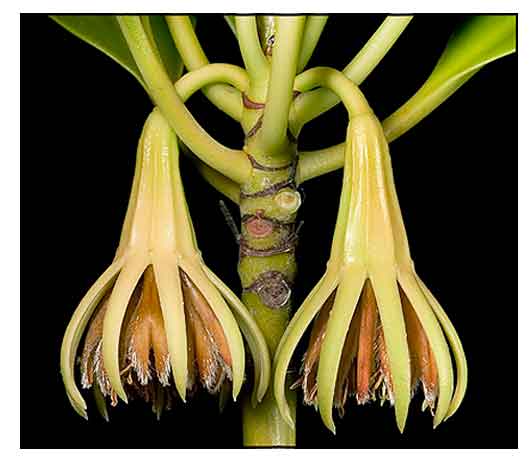 Botany Botany
Rhizophora stylosa is a tree or shrub, with aerial roots. Stipules reddish, sessile, leaflike, lanceolate. Leaves opposite or distichous; leaf blade glabrous, midvein extended into a caducous point, margin entire or serrulate near apex. Inflorescences axillary, dense cymes. Bracteoles forming a cup just below flower. Calyx tube adnate to ovary, persistent; lobes 5-8. Petals 4, lanceolate. Stamens 8-12; filaments much shorter than anthers or absent; anthers introrse, locules many, dehiscing by an adaxial valve. Ovary inferior, 2-loculed, apically partly surrounded by a disk, free part elongating after anthesis; style 1, sometimes very short; stigmas 4. Fruit brown, ovoid, ovoid-conic, or pyriform. Fertile seed 1 per fruit; germination viviparous; hypocotyl protruding to 78 cm before propagule falls. (Flora of China)
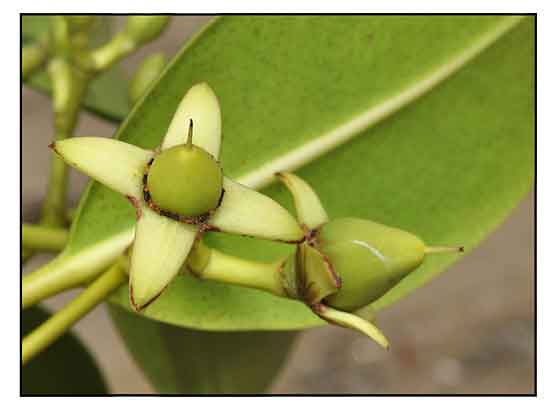 Rhizophora stylosa is a small to medium-sized erect tree, can grow up or over to 10 m. Crown is conical. Smooth, gray to black fissured bark, trunk diameter can reach up to 10 - 15 cm. Stilt roots measuring up to 3 m long and sometimes aerial roots emerging from the lower branches. Leathery leaves, broadly elliptic, measuring 6.5 - 12.5 by 3 - 7.5 cm, has tiny black dots on the lower surface and a pointed tip. Leaf stalk is 1 - 3.5 cm long and with 4 - 6 cm long leaflets at its base. Flowers are composed of cream-colored, linear petals arranged in a cross-shaped pattern. Flower heads are located in the axils and forked 3 - 5 times, with 5 - 8 bisexual flowers, each on a 2.5 - 5 cm long stalk. Flower buds are widest near the base. Four pale-yellow calyx lobes remain present on the fruit and are recurved. The four yellowish to whitish petals are 8 mm long and have densely woolly margins. Each flower has 8 stamens and a 4 - 6 mm long style. Brown, pear-shaped fruit hang with the smaller end pointed down. A long, cylindrical propagule emerges from the smaller end, while the fruit is still attached to the parent plant. This condition is known as viviparity. Propagule measures 20 - 35 cm long. (3) Rhizophora stylosa is a small to medium-sized erect tree, can grow up or over to 10 m. Crown is conical. Smooth, gray to black fissured bark, trunk diameter can reach up to 10 - 15 cm. Stilt roots measuring up to 3 m long and sometimes aerial roots emerging from the lower branches. Leathery leaves, broadly elliptic, measuring 6.5 - 12.5 by 3 - 7.5 cm, has tiny black dots on the lower surface and a pointed tip. Leaf stalk is 1 - 3.5 cm long and with 4 - 6 cm long leaflets at its base. Flowers are composed of cream-colored, linear petals arranged in a cross-shaped pattern. Flower heads are located in the axils and forked 3 - 5 times, with 5 - 8 bisexual flowers, each on a 2.5 - 5 cm long stalk. Flower buds are widest near the base. Four pale-yellow calyx lobes remain present on the fruit and are recurved. The four yellowish to whitish petals are 8 mm long and have densely woolly margins. Each flower has 8 stamens and a 4 - 6 mm long style. Brown, pear-shaped fruit hang with the smaller end pointed down. A long, cylindrical propagule emerges from the smaller end, while the fruit is still attached to the parent plant. This condition is known as viviparity. Propagule measures 20 - 35 cm long. (3)
Distribution
- Native to the Philippines.
- Also native to Andaman Is., Australia, Bismarck Archipelago, Cambodia, Caroline Is., China, Fiji, Gilbert Is., Hainan, Jawa, Lesser Sunda Is., Malaya, Maluku, Marianas, Nansei-shoto, New Caledonia, New Guinea, New South Wales, Northern Territory, Queensland Society Is., Solomon Is., Sulawesi, Tonga, Tuvalu, Vietnam. (1)
- In tidal habitats on mud, sands, coarse grits and rocks; banks and tidal rivers; coastal environments or landward margins of mangroves. (3)
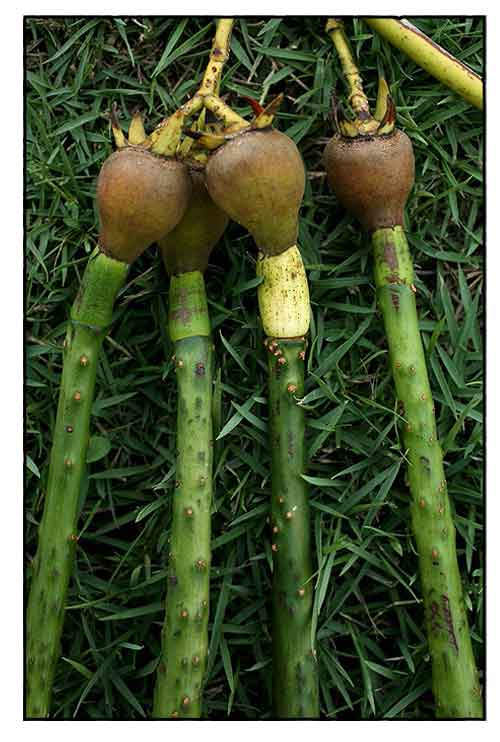 Constituents Constituents
- R. stylosa is rich in alkaloids, flavonoids, phenolic acids, tannins, terpenoids, saponins, and steroids. (2)
- Flavonoids are the most prevalent secondary metabolites: astilbin (12) rutin (13) kaempferol 3-rutinoside (14) from the leaves of the plant; quercetin-3-O-galactopyranoside (15), procyanidin (16), and prodelphinidin (17) in fruit extracts; 3,7-O-diacetyl (−)-epicatechin (18), (−)-epicatechin (19), 3-O-acetyl (−)-epicatechin (20), (+)-afzelechin (21), (+)-catechin (22), 3,3′,4′,5,7-O-pentaacetyl (−)-epicatechin (23), and proanthocyanidin B2 (24), cichnonain Ib (25), cichnonain IIa (26), cichonain IIb (27), (+)-cathecin 3-O-α-L-rhamnoside (28), cichnonain Ia (29), glabraoside A (30), and glabraoside B (31) from stems and twigs. (5)
- Study of methanol extract of leaves isolated (6S,7E,9R)-6,9-dihydroxy-4,7-megastiymadien-3-one 9-O-[α-L-arabinopyranosyl-(l→6)-β-D-glucopyranoside] (1), blumenol A (2), and kaempferol 3-rutinoside (3). (see study below) (7)
- Phytochemical screening of methanol extract of leaves yielded alkaloids, phenols, flavonoids, tannins, steroids, terpenoids, with absence of anthocyanins, cardiac glycoside, and saponins. (see study below) (8)
- Study of stems and twigs isolated seven pentacyclic triterpenoids: 3β-O-(E)-coumaroyl-15α-hydroxy-β-amyrin (1), 15α-hydroxy-β-amyrin (2), 3β-taraxerol (3), 3β-taraxerol formate (4), 3β-taraxerol acetate (5), 3β-O-(E)-coumaroyl-taraxerol (6), and 3β-O-(Z)-coumaroyl-taraxerol (7). (10)
Properties
Studies have suggest antioxidant, antimicrobial properties.
Parts used
Bark, roots, leaves.
Uses
Edibility.
- In Indonesia, the fruit and cotyledon are processed into coffee and tea. (see study below) (9)
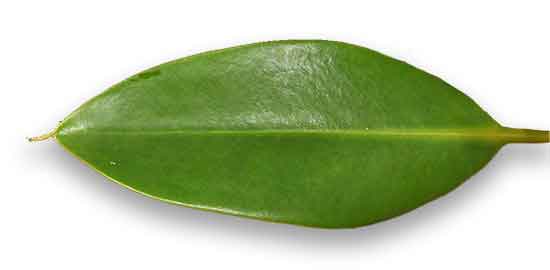 Folkloric Folkloric
- In Indonesia, the bark, young roots, and leaves used for the treatment of oral thrush, rheumatism, wounds, liver disorders, hematuria. For thrush in infants, young roots are crushed in the mouth and followed by water. Decotion of leves and stems drunk twice daily for liver problems and "lusiang" diseases, including muscle pain, back pain, bone pain, and rheumatism. For wound healing, the fruit (propagule) is crushed and applied to the wound surface until bleeding stops. Fruit fermented in light wine is drunk to cure hematuria (blood in the urine). (5)
Others
- Wood: Used for firewood and charcoal.
- Agroforestry: Extensive set of prop roots help disperse strong tidal waves, protecting the shoreline and surrounding areas. (3)
Studies
• Antibacterial / Leaves and Bark: Study evaluated petroleum ether, chloroform, and methanol extracts of leaves and bark or Rhizophora stylosa for antimicrobial properties against Staphylococcus aureus, S. epidermis, Streptococcus pyogenes, Escherichia coli, Klebsiella pneumonia and Pseudomonas aeruginosa. The bark extract showed more potency than the leaf extracts. The chloroform extracts showed highest antimicrobial activity with MIC of 0.1 mg/ml and MBC of 6.3 mg/ml. (6)
• Antimicrobial Compounds / Leaves: Study of methanol extract of leaves isolated (6S,7E,9R)-6,9-dihydroxy-4,7-megastiymadien-3-one 9-O-[α-L-arabinopyranosyl-(l→6)-β-D-glucopyranoside] (1), blumenol A (2), and kaempferol 3-rutinoside (3). All compounds exhibited antimicrobial activity and were isolated from the genus for the first time. (7)
• Antioxidant / Leaves: Study evaluated methanol and ethyl acetate extracts of Rhizophora stylosa, R. mucronata, and R. apiculata for phytoconstituents and antioxidant activity. The ethyl acetate extracts showed greater variety of metabolites than the methanol extract. Both EA and ME demonstrated significant anti-DPPH radical activity. R. stylosa showed second highest antioxidant activity with IC50 0.37 g/mL, and 1.16 g/mL in ethyl acetate extract. Results suggest potential as natural antioxidant. (see constituents above) (8)
• Coffee and Tea Mangrove / Antioxidant / Condensed Tannins / Fruits and Leaves: Study evaluated the bioactive compounds and antioxidant activity of coffee and tea mangrove produced from the fruit of R. stylosa. The coffee mangrove was composed of powders of mangrove fruits, ginger (Z. officinale) and Javanese long peppers (Piper retrofractum), all ingredients prepared through sun-drying, roasting and grinding. Mangrove fruit powder and coffee mangrove showed partially good potent activity, while sames of ginger and long pepper showed relatively low activity. Tea mangrove was a plain coarse powder from mangrove fruits. Tea mangrove exhibited the highest antioxidant activity with IC50 less than BHA (IC50 1.56 µg/ml) but higher than trolox (IC50 4.21 µg/ml). Antioxidant activities of tea mangrove extract of mangrove fruit extract are mostly induced by condensed tannins. Results suggest high antioxidant activities of coffee and tea mangroves originated from the mangrove fruit. (9)
• Protective Against Dental Bacterial Bioflms / Leaf and Bark: Study evaluated the antimicrobial effect of R. stylosa leaf and bark extracts (petroleum ether, chloroform, and methanol) against selected consortium of dental biofilms such as Streptococcus pyogenes, Pseudomonas aeruginosa, Staphylococcus aureus and S. salivarius by MIC and minimum biofilm eradication concentration (MBEC). A petroleum ether extract exhibited better antimicrobial activity than other extracts, and the biofilms with S. aureus and S. salivarius were the most susceptible resistant microorganism to the extract. (11)
• Silver Nanoparticles / Leaves: Study reported on the safe and environmentally friendly biosynthesis of silver nanoparticles using R. stylosa mangrove leaf extract as nontoxic stabilizer, reducing and capping agent. The AgNPs showed good antibacterial and antioxidant activity compared to the pure plant extract. Antibacterial activity was higher against E. coli than S. aureus. Antioxidant activity by DPPH assay was attributed to a flavonol derivative and content of phenolics, flavonoids, and polysaccharides. Results showed potential for biomedical applications. (12)
Availability
Wild-crafted.
|

![]()








